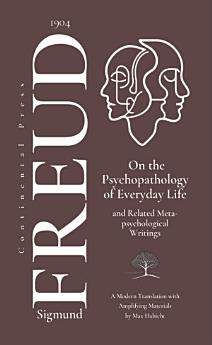On the Psychopathology of Everyday Life: and Related Metapsychological Writings
May 2024 · The Collected Complete Works of Sigmund Freud Book 8 · Continental Press
Ebook
211
Pages
family_home
Eligible
info
reportRatings and reviews aren’t verified Learn More
About this ebook
A modern rendering of Sigmund Freud’s influential 1904 work On the Psychopathology of Everyday Life (Zur Psychopathologie des Alltagslebens), followed by his 1905 essay The Joke and Its Relation to the Unconscious (Der Witz und seine Beziehung zum Unbewußten). This unique edition brings together two of Freud’s most accessible yet profound explorations of metapsychology, examining how unconscious processes manifest in seemingly trivial aspects of daily life, such as slips of the tongue, forgetfulness, and humor. In On the Psychopathology of Everyday Life, Freud introduces the concept of the “Freudian slip,” demonstrating how unconscious thoughts and emotions influence even the most mundane actions. He argues that these seemingly accidental errors—such as forgetting names, misplacing objects, or misspeaking—are not random but reveal hidden desires, conflicts, and anxieties. Through detailed examples drawn from his own life and clinical practice, Freud illustrates how the unconscious mind intrudes into conscious behavior, offering a window into the deeper workings of the psyche. This work popularized the idea that “there are no accidents” in mental life, profoundly influencing both psychology and popular culture. The Joke and Its Relation to the Unconscious extends Freud’s analysis to the realm of humor, exploring how jokes provide a socially acceptable outlet for repressed thoughts and emotions. Freud argues that jokes, like dreams, rely on mechanisms such as condensation, displacement, and symbolism to bypass the censoring function of the conscious mind. He distinguishes between innocent jokes, which serve primarily to entertain, and tendentious jokes, which express aggression, sexuality, or critique. This essay not only sheds light on the psychological underpinnings of humor but also underscores the pervasive influence of the unconscious in shaping human behavior. This fresh, modern translation from the original German manuscript breathes new life into these historically significant works. Freud’s extensive writings have often been inaccessible to the general reader, and this edition seeks to bridge that gap by providing direct access to his original ideas. The Reader’s Edition introduces Freud’s work in context, with an illuminating Afterword that explains his philosophical project, situates it within the Modernist milieu, and explores its enduring impact on contemporary thought. The Afterword also examines the relationship and intellectual conflict between Freud and Carl Jung, particularly their differing views on the nature of the unconscious. The included works are: 1905: Bruchstück einer Hysterie-Analyse / Fragment of an Analysis of Hysteria 1908: Hysterische Phantasien und ihre Beziehung zur Bisexualität / Hysterical Fantasies and Their Relationship to Bisexuality 1909: Allgemeines über den hysterischen Anfall / General Remarks on the Hysterical Attack 1909: Bemerkungen über einen Fall von Zwangsneurose / Remarks on a Case of Obsessive-Compulsive Neurosis 1909: Analyse der Phobie eines fünfjährigen Knaben / Analysis of the Phobia of a Five-Year-Old Boy 1911: Psychoanalytische Bemerkungen über einen autobiographisch beschriebenen Fall von Paranoia (Dementia paranoides) / Psychoanalytic Remarks on an Autobiographically Described Case of Paranoia (Dementia Paranoides) 1918: Aus der Geschichte einer infantilen Neurose / From the History of an Infantile Neurosis 1922: Über einige neurotische Mechanismen bei Eifersucht / On Some Neurotic Mechanisms in Jealousy
About the author
Sigmund Freud (1856-1939) was an Austrian neurologist and the founder of psychoanalysis, a groundbreaking approach to understanding the human psyche. Freud introduced concepts such as the unconscious mind, repression, and the tripartite structure of the psyche, which includes the id, ego, and superego. His work, including seminal texts like The Interpretation of Dreams and Beyond the Pleasure Principle, emphasized the role of unconscious drives and childhood experiences in shaping behavior and personality. Freuds theories on sexuality, defense mechanisms, and dream analysis challenged societal norms and profoundly altered the field of psychology, influencing literature, art, and philosophy. Though controversial, his contributions laid the foundation for modern psychotherapy and continue to spark debates and inspire new approaches to understanding human behavior and mental processes.
Rate this ebook
Tell us what you think.
Reading information
Smartphones and tablets
Install the Google Play Books app for Android and iPad/iPhone. It syncs automatically with your account and allows you to read online or offline wherever you are.
Laptops and computers
You can listen to audiobooks purchased on Google Play using your computer's web browser.
eReaders and other devices
To read on e-ink devices like Kobo eReaders, you'll need to download a file and transfer it to your device. Follow the detailed Help Center instructions to transfer the files to supported eReaders.











